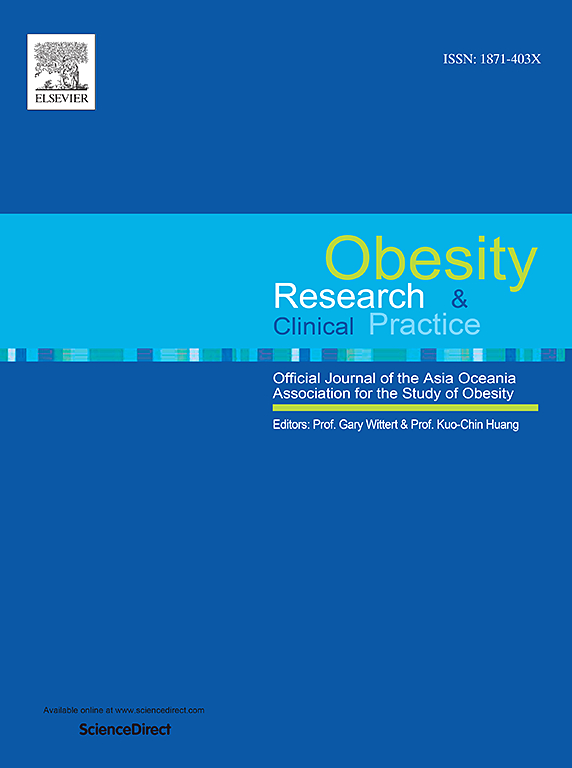Association between obesity and prevalence of significant regurgitant valvular heart disease over time: A cohort study
IF 2.5
4区 医学
Q3 ENDOCRINOLOGY & METABOLISM
引用次数: 0
Abstract
Background
The association between valvular heart disease and obesity is poorly documented. The present study evaluated the prevalence and worsening over time of valvular regurgitation by obesity category.
Methods
This cohort study included 11385 patients who underwent two echocardiographic examinations at least 1 year apart. Mitral, tricuspid, and aortic regurgitation were graded at the first and last visits. Regurgitation worsening was defined as those going from non/trace to moderate/severe or from moderate to severe. Frequency and worsening of regurgitant valvular heart disease were evaluated across body mass index (BMI) categories and adjusted for age, sex, follow-up time, and significant regurgitation at first exam.
Results
Patients aged 63 ± 15 years old at the last visit (43 % women, 29 % with obesity, median follow-up time of 3 years [interquartile range 2–6]). Valve regurgitation was more common in patients without obesity than in those with obesity across all age groups. The prevalence of mitral, tricuspid and aortic valve regurgitations at the last visit diminished for increased BMI categories: 24 %, 19 %, 16 % and 14 % for patients with normal weight, overweight, obesity and severe obesity, respectively (p < 0.001). The regurgitation worsening observed in any valve followed a similar trend: 14 %, 11 %, 9 % and 8 %, respectively (p < 0.001). These inverse associations with BMI remained significant after adjustments for cofactors.
Conclusions
Obesity was associated with lower valvular regurgitation prevalence and worsening that persisted in the mitral and tricuspid valves after adjusting for confounders and excluding patients changing weight over time, suggesting the existence of an obesity paradox in valvular heart diseases.
随着时间的推移,肥胖与显著反流性瓣膜性心脏病患病率之间的关系:一项队列研究。
背景:关于瓣膜性心脏病和肥胖之间的关系文献很少。本研究评估了肥胖类别的瓣膜反流的患病率和随时间的恶化情况。方法:本队列研究纳入11385例患者,间隔至少1年接受两次超声心动图检查。二尖瓣、三尖瓣和主动脉瓣返流在首次和最后一次就诊时进行分级。反流加重定义为从无/迹到中度/重度或从中度到重度。通过身体质量指数(BMI)分类评估反流性瓣膜性心脏病的频率和恶化程度,并根据年龄、性别、随访时间和首次检查时明显的反流进行调整。结果:患者末次访诊年龄为63岁 ± 15岁(43 %为女性,29 %为肥胖,中位随访时间为3年[四分位数间距2-6])。在所有年龄组中,无肥胖患者的瓣膜反流比肥胖患者更常见。随着BMI指数的增加,最后一次就诊时二尖瓣、三尖瓣和主动脉瓣反流的发生率降低:正常体重、超重、肥胖和严重肥胖患者的二尖瓣、三尖瓣和主动脉瓣反流发生率分别为24 %、19 %、16 %和14 % (p )。在调整混杂因素并排除体重随时间变化的患者后,肥胖与二尖瓣和三尖瓣持续恶化的瓣膜反流发生率较低有关,这表明在瓣膜性心脏病中存在肥胖悖论。
本文章由计算机程序翻译,如有差异,请以英文原文为准。
求助全文
约1分钟内获得全文
求助全文
来源期刊

Obesity research & clinical practice
医学-内分泌学与代谢
CiteScore
7.10
自引率
0.00%
发文量
80
审稿时长
49 days
期刊介绍:
The aim of Obesity Research & Clinical Practice (ORCP) is to publish high quality clinical and basic research relating to the epidemiology, mechanism, complications and treatment of obesity and the complication of obesity. Studies relating to the Asia Oceania region are particularly welcome, given the increasing burden of obesity in Asia Pacific, compounded by specific regional population-based and genetic issues, and the devastating personal and economic consequences. The journal aims to expose health care practitioners, clinical researchers, basic scientists, epidemiologists, and public health officials in the region to all areas of obesity research and practice. In addition to original research the ORCP publishes reviews, patient reports, short communications, and letters to the editor (including comments on published papers). The proceedings and abstracts of the Annual Meeting of the Asia Oceania Association for the Study of Obesity is published as a supplement each year.
 求助内容:
求助内容: 应助结果提醒方式:
应助结果提醒方式:


